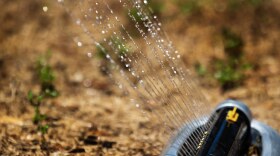Georgetown, the fastest growing city in the U.S. and home to more than 86,000 people, must find a new water source by 2030 in order to avoid supply shortages, according to a city report.
It's something Jonathan Moore thinks about a lot.
Since moving to Georgetown in 2021, Moore said the city, which runs its own water utility, has struggled to meet customers' demand multiple times. That includes last summer, when drought and construction delays on one of Georgetown's water treatment plants forced the city to impose strict outdoor water restrictions.
For the most part, Moore has taken these restrictions in stride. A self-described "avid vegetable gardener," he said he's always looking for better and more efficient ways to use water.
"If you do an open water system like a sprinkler, most of that water gets wasted. It really doesn’t water really well," he said. "So I’ve had to use things more conscientious like drip systems and timers — particularly timers that are aware of what the environment is doing, so you aren’t watering in the middle of a rainstorm. That kind of thing."
Still, Moore wonders if it’s enough. He’s concerned the city continues to be more reactive than proactive in its approach to water.
"Kind of a strange thing, you know, if we’re already restricted to watering on certain days of the week, and there’s more and more houses being built, but the capacity isn’t coming online very fast," he said.
Supply and demand
The majority of Georgetown's water supply comes from lakes Georgetown, Stillhouse and Belton. It also receives some water from Lake Travis and draws groundwater from the Edwards Aquifer.
Up until two years ago, it was thought these sources would provide Georgetown enough water until around 2043 — perhaps past 2050 with enough conservation.
But not anymore.
With the population booming, the city has since learned its water demand is on pace to surpass supply in just six years.
Georgetown's water utilities director, Chelsea Solomon, said the city immediately began searching for additional water supply options — a challenging task.
"You can’t produce more water," she said. "You can treat more water, but you can’t produce it. You can produce more electricity, but water is a finite resource."

Last summer, Georgetown signed an agreement with another local water utility, EPCOR, to set aside at least 39,000-acre feet of groundwater from the Carrizo-Wilcox Aquifer in Robertson County — just north of the Bryan-College Station area. The goal is for Georgetown to receive treated groundwater from the aquifer by 2030, but there is still work to be done to finalize the plan.
"Surface water is what 90% of our water right now ... but getting groundwater allows us to diversify our resources some, so that we’re not wholly dependent on surface water and it’s a little bit more drought tolerant," Solomon said.
Education and conservation
In addition to searching for new water sources, Solomon said the city has ramped up its conservation efforts.
“It’s something that we’re putting more and more emphasis on," she said. "We get a lot of customers that come from out-of-state ... so having people come here, really kind of the most important step initially is education."
That's where Georgetown's water utility regulatory and conservation manager comes in. Tiffany Diaz said a large part of her job involves helping people reconsider how much water they use on a day-to-day basis.

"How important is it for us to have lush green yards in the summer versus maybe incorporating native Texas landscaping?" she said. "Looking at reuse opportunities, as well as ultimately just using less water.”
While Diaz said she knows some people will always prefer to have lush green yards, she's been encouraged by people's growing interest in the topic of water.
"We really have seen some improvement in how customers are looking at their water usage," she said. "We’re seeing a lot more folks interested in learning more and applying for our rebates, so it’s been promising."








